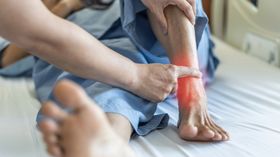How Long Does It Take to Recover From Posterior Tibial Tendonitis?
Read this post to find out causes, aggravating factors, treatment options, and possible recovery time for posterior tibial Tendonitis
Updated February 13, 2023
The posterior tibial tendon is one of the most important supporting structures in the foot that assists in walking. Changes in the tendon can induce posterior tibial tendon dysfunction (PTTD), which impairs the tendon's capacity to maintain the arch. The foot arch might flatten as a result of this.
Because it is the most prevalent type of flatfoot that develops throughout adulthood, PTTD is also known as adult acquired flatfoot. Although this condition usually affects only one foot, it might affect both feet in some persons. PTTD is frequently progressive which will continue to worsen if not treated promptly.
Treatment for Posterior Tibial Tendonitis
There isn't necessarily a fastest way to heal posterior tibial tendonitis, as everyone is different. Severe cases of PTTD might require surgery, but most cases can usually be treated at home with the following methods:
- Eliminating activities that aggravate the pain It is beneficial to switch to low-impact activities like biking, elliptical machines, and swimming.
- Using medication The fastest way to heal PTTD’s pain and inflammation is with drugs like ibuprofen and naproxen.
- Using cold/ice packs To keep swelling down, apply cold packs to the most painful part of the posterior tibial tendon for 20 minutes at a time, 3 or 4 times a day. Avoid putting ice directly on your skin to avoid a cold burn.
- Exercising Performing strengthening, stretching, and range of motion exercises for posterior tibial tendonitis can help strengthen and ease tension in the tendon, facilitating better outcomes and healing. Note: Make sure you acclimate slowly and do exercises at tolerable levels. Additionally, for optimal biomechanics while exercising, wear firm-fitting shoes.
- Using custom orthotics Custom orthotics for PTTD can help stabilize your feet and assist in the healing process.
Recovery Time for Posterior Tibial Tendonitis
Posterior tibial tendon dysfunction is a chronic ailment that worsens over time but can be cured. Early and intensive conservative treatment of posterior tibial tendon insufficiency can prevent adult acquired flat foot deformity.
Regular PTTD healing time takes 6-8 weeks. Early activity on a regenerating tendon or noncompliance with recommended treatment might cause a setback in recovery. Additionally, as with any tendon injury, PTTD recovery can take longer than usual, potentially up to months, depending on the severity of the damage.
Causes and Aggravating Factors of Posterior Tibial Tendonitis
The posterior tibial tendon can be torn or inflamed due to an acute injury, such as a fall. Overuse can potentially cause the tendon to rupture. People who participate in high-impact sports such as basketball, tennis, or soccer, for example, may experience tendon tears as a result of repeated use. The arch will gradually collapse (collapse) over time if the tendon gets irritated or damaged.
You may be at risk for developing or worsening the condition if you:
- Are obese
- Have poor circulation
- Have inflammatory diseases
- Are over 40-years-old
- Are female
» Prevent sports injuries with the best insoles for tennis players with posterior tibial tendonitis
Related Articles

Benefits of Cycling Orthotics
Upstep Staff
December 5, 2024

The Best Orthotic Insoles for Sesamoiditis
Upstep Staff
December 9, 2024

Ankle Arthritis: Causes, Symptoms, and Treatment
Abeera Maham
February 17, 2023

Do You Have Hypothyroidism From Your Burning Feet?
Janik Sundstrom
December 19, 2024

6 Worst Shoes for Achilles Tendonitis: Avoid Foot Pain
Janik Sundstrom
July 11, 2025
Related Posts
Babafemi Adebajo
Posterior Tibial Tendonitis: Symptoms, Causes, & Treatments
Babafemi Adebajo
Best Exercises for Posterior Tibial Tendonitis
Babafemi Adebajo



